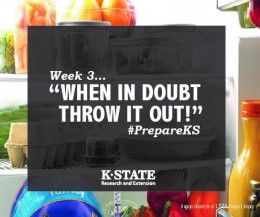Starting Sept. 1, Prepare Kansas 2016 provided tips on keeping food safe in emergency situations. This year’s program was conducted through the K-State Research and Extension Facebook page and here on the blog. Also, each week Jamie Vineyard Rathbun was live on Facebook talking about the weekly challenges.
Here’s a re-cap of the weekly themes and challenges.
 Week 1: What can you do ahead of a power outage? This week we focused on activities that all of us can do before the power goes out. We challenged folks to put a thermometer in each of their refrigerators and freezers. We asked folks to post of picture on the K-State Research and Extension Facebook page
Week 1: What can you do ahead of a power outage? This week we focused on activities that all of us can do before the power goes out. We challenged folks to put a thermometer in each of their refrigerators and freezers. We asked folks to post of picture on the K-State Research and Extension Facebook page
 Week 2: What you can you do when the power goes out? The week we focused on making sure folks know that when the power goes out it is important to keep the refrigerator and freezer doors closed as much as possible. We also talked about how to keep food safe. We challenged folks to find out where they can obtain block or dry ice in their communities. We asked folks to share what they learned via social media.
Week 2: What you can you do when the power goes out? The week we focused on making sure folks know that when the power goes out it is important to keep the refrigerator and freezer doors closed as much as possible. We also talked about how to keep food safe. We challenged folks to find out where they can obtain block or dry ice in their communities. We asked folks to share what they learned via social media.
Week 3: What can you do after a power outage? This week we focused on how to decide if food is safe to keep or not after an extended power outage. Never taste food to determine if it is safe or not! We challenged folks go through their refrigerators and freezers and throw items out that have been there longer than the recommended storage time. After doing that,we challenged folks to clean the inside of their refrigerators. We asked folks to share one thing they learn about keeping food safe when the power goes out.
 Week 4: What can you do after a flood? This week we focused on how to handle food that has come into contact with flood water. We also talked about the importance of handwashing after coming into contact with flood water. We challenged folks to make sure they were not storing any food, cooking utensils, or pans directly on the floor. We asked folks to take a picture of a cooking utensil or pan and say whether or not it would be safe to keep after coming into contact with flood water.
Week 4: What can you do after a flood? This week we focused on how to handle food that has come into contact with flood water. We also talked about the importance of handwashing after coming into contact with flood water. We challenged folks to make sure they were not storing any food, cooking utensils, or pans directly on the floor. We asked folks to take a picture of a cooking utensil or pan and say whether or not it would be safe to keep after coming into contact with flood water.
The 2016 challenge is complete but we post to blog year-round. Look for information about the 2017 #PrepareKS challenge beginning late July.


